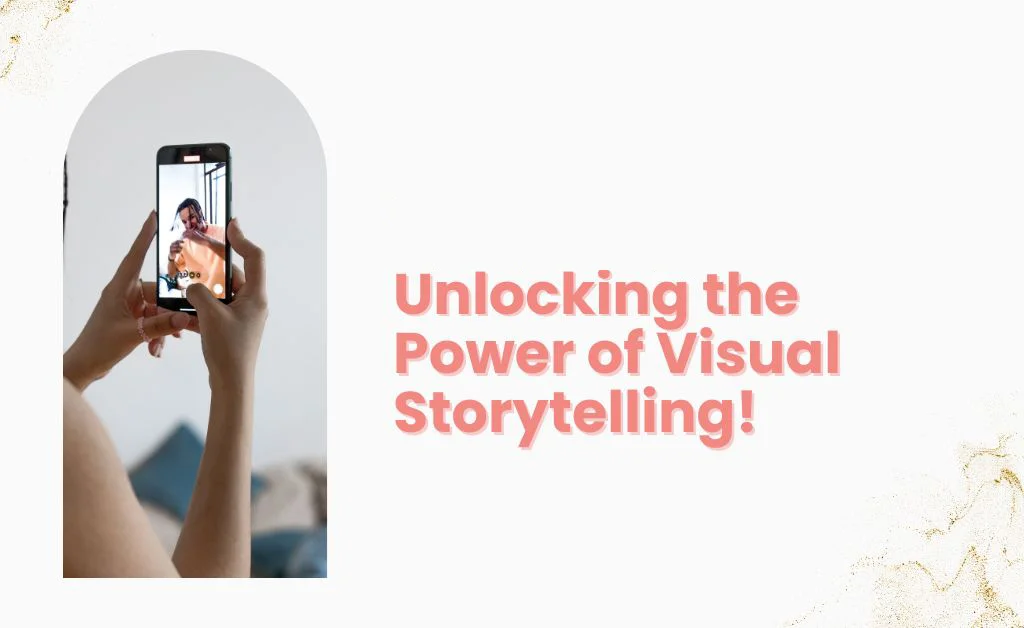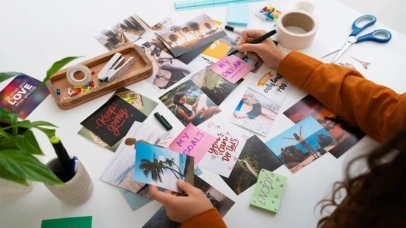 Among the many communication mediums, storytelling sticks out as an ageless and effective way to communicate ideas. The importance of images in narrative has increased while technology progresses. The practice of visual storytelling has influenced many facets of our everyday lives, from the internet and websites to cinema and advertising. We will examine the nuances of visual storytelling in the above article, emphasizing the critical role the artwork provides in creating gripping stories that enthrall viewers and have a lasting impression.The skill of conveying a story, message, or idea via the use of visual elements such as graphics, animations, and photographs is known as visual storytelling. It involves more than just simple illustration; it involves carefully planning a series of images to take the audience on a psychological trip.
Among the many communication mediums, storytelling sticks out as an ageless and effective way to communicate ideas. The importance of images in narrative has increased while technology progresses. The practice of visual storytelling has influenced many facets of our everyday lives, from the internet and websites to cinema and advertising. We will examine the nuances of visual storytelling in the above article, emphasizing the critical role the artwork provides in creating gripping stories that enthrall viewers and have a lasting impression.The skill of conveying a story, message, or idea via the use of visual elements such as graphics, animations, and photographs is known as visual storytelling. It involves more than just simple illustration; it involves carefully planning a series of images to take the audience on a psychological trip.
Comprehending Visual Narrative
- The Storytelling Core:
Storytelling is fundamentally the skill of using an account to convey an opinion and a concept. Stories, whether they are told as part of a marketing campaign, a documentary, and a bedtime tale, have a capacity to emotionally draw in and unite people. Comprehending the foundations of storytelling paves the way for investigating the ways in which visuals can augment and magnify these stories.
- Visual Communication’s Ascent:
The attention spans of individuals are shorter than ever before at an era when websites & screens rule the roost. With pictures and videos frequently delivering messages more effectively than words alone, visual material has emerged as the most common tool for communication. The development of visual communication and its influence on the story shall be discussed in this section.
The Union of Storytelling and Art
- Design’s Place in Visual Storytelling:
Design is a purposeful tool for meaning communication, not merely for aesthetic sake. The elements and design concepts collaborate to lead the viewer through a narrative, regardless of the medium—graphic, web, or multimedia. We’ll dissect the fundamental design ideas that support powerful visual storytelling in this section.
- The design stage Cognition:
It is important to understand the psychological consequences of choices regarding design when creating narratives that connect with viewers. This section will examine all of the ways how designs can elicit feelings, set tone, and impact the entire storytelling experience, ranging from color theory to typography.
Designing Captivating Storytelling Through Visuals:
- Storyboarding: Organizing the Graphic Tour:
A carefully considered strategy has to be devised before one frame is constructed. Storyboarding is a potent technique that artists use to visually define a story in a variety of mediums. This section will discuss the value of storyboarding and offer suggestions for producing powerful visual sequences.
- The Influence of Visual Coherence:
Keeping a coherent narrative needs consistency in design. In film productions as well as corporate identities, visual consistency strengthens the narrative and fosters trust. We’ll look at how to keep visual harmony intact in a story in this section.

Case Studies: Effective Illustrations of Visual Narrative:
- Bringing Characters to Life at Pixar Animation Studios:
Pixar is a master of the visual narrative medium, producing animated pictures that appeal to a wide range of viewers. This section will examine Pixar’s storytelling methodology, paying particular attention to the aesthetic decisions that enhance the films’ emotional resonance.
- National Geographic: Combining Narrative & Photography:
Beautiful images that complement in-depth reporting are a hallmark of National Geographic’s reputation. This section will look at how National Geographic creates intriguing narrative experiences using imagery & style to take audiences to various regions around the globe.
Visual Storytelling’s Futures:
- New Trends and Technology:
As technology develops further, new avenues for visual storytelling become possible. The technologies of augmented and simulated reality, and immersive design are changing narrative techniques. The possible effects of these technologies on the development of visual storytelling will be discussed in this section.
- A Look Into Ethical Issues with Visual Storytelling:
tremendous power with a tremendous deal of responsibility. The growing use of visual narratives raises concerns regarding ethics. The ethical issues that designers must deal well will be addressed in this section, along with the significance for ethical narrative in the modern world.
Why is narrative through images so effective?
- Universal appeal: Pictures speak to more people by transcending cultural and linguistic barriers. Words alone sometimes find it difficult to create the same feelings and comprehension as one visual can.
- Emotional resonance: Images possess the ability to evoke our most profound feelings, eliciting compassion, happiness, and even grief. The message is more memorable and has a greater effect because of this personal connection.
- Enhanced involvement: People are drawn to images by nature. Compared to written content, they capture our attention more quickly and hold it a longer time, which makes it easier to interact with and remember information.
- Better communication: Knowledge and ideas which are complicated can be made less difficult to learn and process via the use of visuals. This works particularly well for novels based on facts or related to technology.
What makes a visually compelling narrative?
- Concept: A compelling main idea or message is necessary for any story. What do you want the people watching you to remember? Prior to creating the images, define your main idea.
- Composition: How components are arranged inside a frame is important. To direct the viewer’s eye and produce a sense of harmony, take into account balance, perspective, and leading lines.
- Color: There are strong psychological connections between colors. Select a color scheme that complements the tone and atmosphere of your narrative. Colors that are cool create a sense of calmness or sadness, whereas vibrant hues arouse enthusiasm and vigor.
- Contrast: Contrast highlights important features and makes items stand noticed. For greater appeal, use flavors, color contrasts, and both dark and light ratios.
- Symbolism: Symbols can give your story more depth and intrigue. Represent intangible concepts or elicit particular feelings with objects, forms, or even colors.
- Hierarchy: Sort information according to importance by emphasizing the most crucial parts. To direct the viewer’s attention and make sure they understand the main points, use contrast, size, and location.
Developing your story in pictures:
- Recognize your audience: Recognize their preferences, interests, and cultural background. Make sure your messaging and images speak to them in a meaningful way.
- Create a story arc: Clearly state the start, middle, and finish of your story. Every image should advance the plot and improve the story’s general rhythm.
- Select the appropriate medium: Think about the benefits and drawbacks of various graphic formats. Each type of media—pictures, illustrations, infographics, and animations—has a certain capacity for communicating stories.
- Continue to be consistent: Make a visual style guide that outlines font, color schemes, and overall tone. Maintaining consistency enhances the overall impact of your tale and helps consumers recognize your brand.
- Iterate and improve: Don’t be scared to try out various strategies and experiments. Consult your audience for comments, then make changes to your images based on their responses.
Beyond the fundamentals:
The discipline of visual storytelling is constantly changing and has countless applications. Investigate the following new trends:
- Interactive storytelling: Use branched paths, clickable parts, or virtual experiences to involve viewers in the narrative.
- Micro-interactions: You may make your images more interesting and memorable by incorporating subtle movements and hover actions.
- Data visualization: Use attractive and informative charts, graphs, & graphics to create captivating narratives out of complicated sets of data.
- Emotional AI: Make use of artificial intelligence to tailor your images to the feelings and moods of your audience to create a superior and engaging experience.
Recall that visual storytelling is about leveraging design to arouse feelings, capture attention, and create a lasting impression—it’s not simply about beautiful images. You can communicate your message better, engage people more deeply, and change the world when you are proficient in the art of multimedia storytelling.
Request for action:
Are you prepared to unleash visual storytelling’s power? In the box for feedback below, convey us on what you’ve learned, pose inquiries, & let’s talk about the art of using design to tell powerful stories!
Extra sources of information:
- The Noun Project: offers an extensive collection of free icons and drawings to meet your demands of visual narratives.
- Canva: An easy-to-use tool for producing beautiful images even in the absence of design knowledge.
- Adobe Creative Cloud: An effective toolkit for visual storytelling at the expert level.
Conclusion:
The use of imagery is the dynamism that results from the marriage of design and narrative in the communication domain. Every component is crucial for creating engaging stories, from the conceptualization of sketches and the emotional nuances of choices in design. Through analyzing prosperous case examples and investigating new patterns, we acquire understanding of the dynamic field of visual narrative. As we proceed, we must accept the responsibility that accompanies this potent medium of expression in order to make sure that our tales are genuinely and morally compelling to viewers everywhere.




